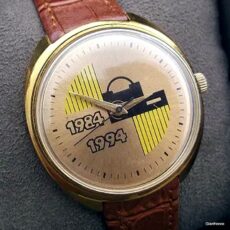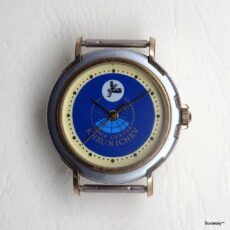Origins of the RAKY Brand
The RAKY brand emerged in the late 1980s and gained popularity in Italy during the early 1990s, amid a growing fascination with Soviet-era aesthetics. Unlike similarly named brands like Raketa (a renowned manufacturer from Petrodvorets) or enigmatic dial markings such as “Raheta,” RAKY was a distinct and autonomous brand created specifically for the Italian market. Evidence suggests these watches were assembled in Italy, not the USSR, using genuine Soviet components such as movements and, in some cases, cases.
Raketa, the original Soviet brand, has always denied involvement with RAKY, confirming that these were not officially produced Soviet models. The name “Raky” appears to echo the better-known “Raketa,” likely chosen to benefit from name recognition while avoiding trademark conflicts. Some RAKY dials featured a curious blend of Latin and Cyrillic characters, coupled with Soviet-themed imagery and invented branding. Rather than outright counterfeits, these were creatively styled fantasy pieces designed for Western consumers.
Some collectors speculate that Italian distributors obtained semi-formal authorisation to use Soviet components and assembled the watches with custom dials to suit the fashion trends of the time. In short, RAKY was a commercial invention—a fantasy brand rooted in Italian ingenuity and Soviet mechanics.
Connections with Other Pseudo-Soviet Brands
RAKY was part of a broader wave of pseudo-Soviet watches created for Western markets in the late 1980s. Alongside RAKY, Italian consumers saw brands like “Big Zero” (inspired by Raketa), “Gaigher” (with Cold War motifs), and others. These watches typically mixed Cyrillic and Latin scripts with Soviet-style graphics. Dials often displayed eccentric slogans and even misused Soviet emblems such as the “CCCP Quality” mark in ways no Soviet designer would have permitted.
While modern Raketa management dismisses these watches as fakes, many collectors have come to appreciate them as artefacts of a unique cultural phenomenon. RAKY and its contemporaries are now valued for their retro aesthetic and role in 1990s fashion, offering insight into how Western markets reinterpreted Soviet design for mass appeal.
Movements and Component Origins
Though not manufactured in Soviet factories, RAKY watches commonly housed authentic Soviet mechanical movements, often from varying origins. Identified calibres include:
- Raketa 2609.HA (manual wind, 17/19 jewels)
- Slava 2427 (automatic, date, 26 jewels)
- Chaika 2125 (compact, possibly quartz, for smaller models)
Interestingly, even dials with “Raketa” inscriptions often contained Slava movements. This suggests distributors sourced whatever was available from across the former USSR, including Raketa (Petrodvorets), Slava (Second Moscow Factory), and Chaika (Uglich).
Cases may have also come from Soviet or Eastern European suppliers, while the dials were almost certainly made in Italy. The frequent Cyrillic misspellings and creative Soviet iconography point to Italian graphic design rather than Soviet production.
The likely assembly process involved combining Soviet stock components (movements and possibly cases) with locally printed dials, creating watches that were half Soviet on the inside and fully Italian in concept and style. As a popular slogan at the time put it: “Russi inside and out.”
Historical and Commercial Context: Italy in the 1990s
The RAKY phenomenon can only be understood in the context of early 1990s Italy, a time when Soviet-themed products became fashionable due to the geopolitical changes of perestroika and the USSR’s collapse. Everything from clothing to cameras to watches gained appeal thanks to their perceived exoticism.
In Italy, two major companies led the Soviet watch craze: Time Trend and Mirabilia. Backed by the official importer Visio (with links to the Soviet Vremex agency), these distributors brought Soviet timepieces to Italian retailers. They did more than just import watches—they adapted them for Italian tastes with upgraded straps, creative packaging, and dedicated advertising campaigns.
Mirabilia, for example, enlisted renowned ad agency Armando Testa to craft marketing around the mystique of the East. Ads depicted Red Army figures and slogans like “The famous Poljots are here: Russian inside and out.” Media coverage also added to the mythos, often exaggerating technical specs and military connections.
Between 1988 and 1991, tens of thousands of Soviet watches were sold in Italy, often as affordable alternatives to Swiss or Japanese models. Even after the fall of the USSR, demand persisted for timepieces still bearing “CCCP” on the dial. To this day, unused stock occasionally surfaces in old jewellery shops, including forgotten RAKY pieces in their original boxes.
Insights from Watch Collectors and Online Forums
As time passed, collectors began piecing together the true story of RAKY through forums like Watchuseek, CCCP-Forum, and Orologiko. The consensus is clear: RAKY was not made by Raketa, but by Italian importers who creatively repurposed Soviet components.
Many forum users refer to them as “Italo-Soviet” watches or third-party productions. While some purists dismiss them as kitschy, others see them as meaningful cultural artefacts. These watches capture the spirit of their time: transitional, bold, and playfully subversive.
Anecdotal evidence from 1990s-era collectors confirms RAKY’s widespread presence in Italian shops. Some recall shelves full of these watches next to genuine USSR-made models. While not officially Soviet, RAKY watches have carved out their own niche in the vintage collecting world.
RAKY Watch Models: Examples and Calibres
| Model Description | Movement (Type and Calibre) | Source/Discussion |
|---|---|---|
| Standard RAKY with USSR-themed dial | Raketa 2609.HA (manual) | URSS.watch catalog |
| “Buran KGB” commemorative model | Slava 2427 (automatic) | Sovietaly collection, Watchuseek |
| Small women’s or quartz RAKY | Chaika 2125 (likely quartz) | URSS.watch export list |
Other versions feature military, space, or comic motifs. While the inner mechanics were often standardised, dial designs varied widely—highlighting the experimental and hybrid nature of the RAKY line.
Conclusion
RAKY watches represent a creative fusion of Italian marketing flair and Soviet horological legacy. Born in a unique historical window, they transformed surplus Soviet mechanics into fashion-forward accessories with mass appeal. Though not officially Soviet, these timepieces have earned their place in horological history as symbols of a short-lived but memorable cultural crossover. Today, they are valued both for their aesthetic charm and for the stories they tell about post-Cold War curiosity and cross-cultural commerce.
Sources: Analysis based on historical forums, collector interviews, archival catalogues, and sources like URSS.watch, CCCP-Forum, Sovietaly.it, and Safonagastrocrono.club.



